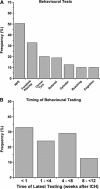A critical appraisal of experimental intracerebral hemorrhage research
- PMID: 22293989
- PMCID: PMC3318157
- DOI: 10.1038/jcbfm.2012.8
A critical appraisal of experimental intracerebral hemorrhage research
Abstract
The likelihood of translating therapeutic interventions for stroke rests on the quality of preclinical science. Given the limited success of putative treatments for ischemic stroke and the reasons put forth to explain it, we sought to determine whether such problems hamper progress for intracerebral hemorrhage (ICH). Approximately 10% to 20% of strokes result from an ICH, which results in considerable disability and high mortality. Several animal models reproduce ICH and its underlying pathophysiology, and these models have been widely used to evaluate treatments. As yet, however, none has successfully translated. In this review, we focus on rodent models of ICH, highlighting differences among them (e.g., pathophysiology), issues with experimental design and analysis, and choice of end points. A Pub Med search for experimental ICH (years: 2007 to 31 July 2011) found 121 papers. Of these, 84% tested neuroprotectants, 11% tested stem cell therapies, and 5% tested rehabilitation therapies. We reviewed these to examine study quality (e.g., use of blinding procedures) and choice of end points (e.g., behavioral testing). Not surprisingly, the problems that have plagued the ischemia field are also prevalent in ICH literature. Based on these data, several recommendations are put forth to facilitate progress in identifying effective treatments for ICH.
Figures





References
-
- Adeoye O, Clark JF, Khatri P, Wagner KR, Zuccarello M, Pyne-Geithman GJ. Do current animal models of intracerebral hemorrhage mirror the human pathology. Transl Stroke Res. 2011;2:17–25. - PubMed
-
- Andaluz N, Zuccarello M, Wagner KR. Experimental animal models of intracerebral hemorrhage. Neurosurg Clin N Am. 2002;13:385–393. - PubMed
-
- Arima H, Wang JG, Huang Y, Heeley E, Skulina C, Parsons MW, Peng B, Li Q, Su S, Tao QL, Li YC, Jiang JD, Tai LW, Zhang JL, Xu E, Cheng Y, Morgenstern LB, Chalmers J, Anderson CS. Significance of perihematomal edema in acute intracerebral hemorrhage: the INTERACT trial. Neurology. 2009;73:1963–1968. - PMC - PubMed
-
- Auriat A, Plahta WC, McGie SC, Yan R, Colbourne F. 17ß-Estradiol pretreatment reduces bleeding and brain injury after intracerebral hemorrhagic stroke in male rats. J Cereb Blood Flow Metab. 2005;25:247–256. - PubMed
Publication types
MeSH terms
LinkOut - more resources
Full Text Sources
Medical
Research Materials

